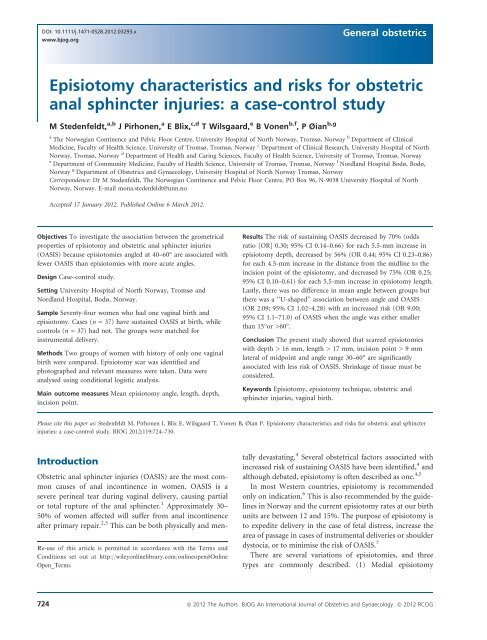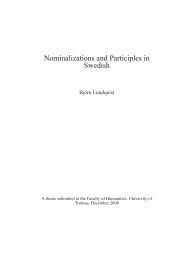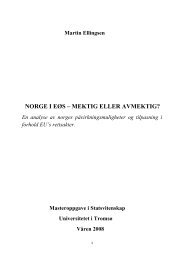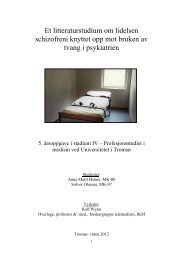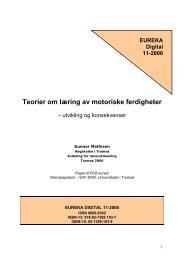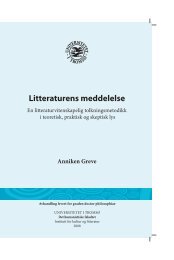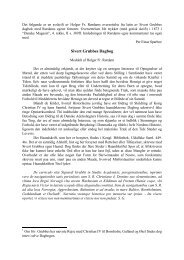Episiotomy characteristics and risks for obstetric anal sphincter ...
Episiotomy characteristics and risks for obstetric anal sphincter ...
Episiotomy characteristics and risks for obstetric anal sphincter ...
Create successful ePaper yourself
Turn your PDF publications into a flip-book with our unique Google optimized e-Paper software.
DOI: 10.1111/j.1471-0528.2012.03293.x<br />
www.bjog.org<br />
<strong>Episiotomy</strong> <strong>characteristics</strong> <strong>and</strong> <strong>risks</strong> <strong>for</strong> <strong>obstetric</strong><br />
<strong>anal</strong> <strong>sphincter</strong> injuries: a case-control study<br />
M Stedenfeldt, a,b J Pirhonen, a E Blix, c,d T Wilsgaard, e B Vonen b,f , P Øian b,g<br />
a The Norwegian Continence <strong>and</strong> Pelvic Floor Centre, University Hospital of North Norway, Tromsø, Norway b Department of Clinical<br />
Medicine, Faculty of Health Science, University of Tromsø, Tromsø, Norway c Department of Clinical Research, University Hospital of North<br />
Norway, Tromsø, Norway d Department of Health <strong>and</strong> Caring Sciences, Faculty of Health Science, University of Tromsø, Tromsø, Norway<br />
e Department of Community Medicine, Faculty of Health Science, University of Tromsø, Tromsø, Norway f Nordl<strong>and</strong> Hospital Bodø, Bodø,<br />
Norway g Department of Obstetrics <strong>and</strong> Gynaecology, University Hospital of North Norway Tromsø, Norway<br />
Correspondence: Dr M Stedenfeldt, The Norwegian Continence <strong>and</strong> Pelvic Floor Centre, PO Box 96, N-9038 University Hospital of North<br />
Norway, Norway. E-mail mona.stedenfeldt@unn.no<br />
Accepted 17 January 2012. Published Online 6 March 2012.<br />
Objectives To investigate the association between the geometrical<br />
properties of episiotomy <strong>and</strong> <strong>obstetric</strong> <strong>anal</strong> <strong>sphincter</strong> injuries<br />
(OASIS) because episiotomies angled at 40–60° are associated with<br />
fewer OASIS than episiotomies with more acute angles.<br />
Design Case–control study.<br />
Setting University Hospital of North Norway, Tromsø <strong>and</strong><br />
Nordl<strong>and</strong> Hospital, Bodø, Norway.<br />
Sample Seventy-four women who had one vaginal birth <strong>and</strong><br />
episiotomy. Cases (n = 37) have sustained OASIS at birth, while<br />
controls (n = 37) had not. The groups were matched <strong>for</strong><br />
instrumental delivery.<br />
Methods Two groups of women with history of only one vaginal<br />
birth were compared. <strong>Episiotomy</strong> scar was identified <strong>and</strong><br />
photographed <strong>and</strong> relevant measures were taken. Data were<br />
<strong>anal</strong>ysed using conditional logistic <strong>anal</strong>ysis.<br />
Main outcome measures Mean episiotomy angle, length, depth,<br />
incision point.<br />
Results The risk of sustaining OASIS decreased by 70% (odds<br />
ratio [OR] 0.30; 95% CI 0.14–0.66) <strong>for</strong> each 5.5-mm increase in<br />
episiotomy depth, decreased by 56% (OR 0.44; 95% CI 0.23–0.86)<br />
<strong>for</strong> each 4.5-mm increase in the distance from the midline to the<br />
incision point of the episiotomy, <strong>and</strong> decreased by 75% (OR 0.25;<br />
95% CI 0.10–0.61) <strong>for</strong> each 5.5-mm increase in episiotomy length.<br />
Lastly, there was no difference in mean angle between groups but<br />
there was a ‘‘U-shaped’’ association between angle <strong>and</strong> OASIS<br />
(OR 2.09; 95% CI 1.02–4.28) with an increased risk (OR 9.00;<br />
95% CI 1.1–71.0) of OASIS when the angle was either smaller<br />
than 15°or >60°.<br />
Conclusion The present study showed that scarred episiotomies<br />
with depth > 16 mm, length > 17 mm, incision point > 9 mm<br />
lateral of midpoint <strong>and</strong> angle range 30–60° are significantly<br />
associated with less risk of OASIS. Shrinkage of tissue must be<br />
considered.<br />
Keywords <strong>Episiotomy</strong>, episiotomy technique, <strong>obstetric</strong> <strong>anal</strong><br />
<strong>sphincter</strong> injuries, vaginal birth.<br />
Please cite this paper as: Stedenfeldt M, Pirhonen J, Blix E, Wilsgaard T, Vonen B, Øian P. <strong>Episiotomy</strong> <strong>characteristics</strong> <strong>and</strong> <strong>risks</strong> <strong>for</strong> <strong>obstetric</strong> <strong>anal</strong> <strong>sphincter</strong><br />
injuries: a case-control study. BJOG 2012;119:724–730.<br />
Introduction<br />
Obstetric <strong>anal</strong> <strong>sphincter</strong> injuries (OASIS) are the most common<br />
causes of <strong>anal</strong> incontinence in women. OASIS is a<br />
severe perineal tear during vaginal delivery, causing partial<br />
or total rupture of the <strong>anal</strong> <strong>sphincter</strong>. 1 Approximately 30–<br />
50% of women affected will suffer from <strong>anal</strong> incontinence<br />
after primary repair. 2,3 This can be both physically <strong>and</strong> men-<br />
Re-use of this article is permitted in accordance with the Terms <strong>and</strong><br />
Conditions set out at http://wileyonlinelibrary.com/onlineopen#Online<br />
Open_Terms<br />
General <strong>obstetric</strong>s<br />
tally devastating. 4 Several <strong>obstetric</strong>al factors associated with<br />
increased risk of sustaining OASIS have been identified, 4 <strong>and</strong><br />
although debated, episiotomy is often described as one. 4,5<br />
In most Western countries, episiotomy is recommended<br />
only on indication. 6 This is also recommended by the guidelines<br />
in Norway <strong>and</strong> the current episiotomy rates at our birth<br />
units are between 12 <strong>and</strong> 15%. The purpose of episiotomy is<br />
to expedite delivery in the case of fetal distress, increase the<br />
area of passage in cases of instrumental deliveries or shoulder<br />
dystocia, or to minimise the risk of OASIS. 7<br />
There are several variations of episiotomies, <strong>and</strong> three<br />
types are commonly described. (1) Medial episiotomy<br />
724 ª 2012 The Authors BJOG An International Journal of Obstetrics <strong>and</strong> Gynaecology ª 2012 RCOG
is per<strong>for</strong>med as an incision dividing the perineal tissue in<br />
the midline down toward the <strong>anal</strong> c<strong>anal</strong>. 5 (2) Mediolateral<br />
episiotomy has its incision point at the midline raising an<br />
angle between 40 <strong>and</strong> 60° to the left or right of the <strong>anal</strong><br />
c<strong>anal</strong>. 7–10 (3) Lateral episiotomy has its incision point to<br />
the left or right of the midline, at either 4–5 or 7–8 o’clock<br />
<strong>and</strong> the cut is angled 40–60° from the midline. 11<br />
There is strong evidence against midline episiotomy,<br />
showing a clear association with increased risk of<br />
OASIS. 5,12,13 Consensus is lacking regarding the role of<br />
mediolateral episiotomy. 5 Recent studies indicate that<br />
mediolateral episiotomy is protective against OASIS 10 both<br />
during operative vaginal deliveries 14 <strong>and</strong> <strong>for</strong> primiparous<br />
women. 15 However, Andrews et al. 8 per<strong>for</strong>med a prospective<br />
study showing that mediolateral episiotomy is a strong<br />
risk factor <strong>for</strong> perineal trauma. Two large cohort studies<br />
indicate that mediolateral episiotomy is protective in first<br />
vaginal delivery, whereas <strong>for</strong> the second or higher vaginal<br />
delivery it is not. 15,16<br />
Questions about the specific technique as well as about the<br />
common definition of mediolateral episiotomy have been<br />
raised. 7,11,17 Kalis et al. 11 revealed how definitions of mediolateral<br />
episiotomy used in European hospitals had a low<br />
degree of agreement <strong>and</strong> a vast range of individual interpretation.<br />
Other studies have shown how health professionals<br />
per<strong>for</strong>m mediolateral episiotomies differently, causing some<br />
episiotomies to lie closer to the midline than intended. 7,9,17<br />
This discrepancy in definition <strong>and</strong> technique highlights the<br />
question whether inaccurate conclusions might have been<br />
drawn, <strong>and</strong> if it might be misleading to compare reports. 5,17<br />
However, studies evaluating the episiotomy technique<br />
revealed that the angle is significantly associated with OASIS<br />
<strong>and</strong> that such injuries seem to occur more often when the<br />
angle of the mediolateral episiotomy is
Stedenfeldt et al.<br />
Figure 1. Adapted from Andrews et al. 17 which illustrates the<br />
measurements taken. a = line drawn from the posterior fourchette to<br />
the outer edge of the <strong>anal</strong> epithelium; b = episiotomy depth, a line<br />
from the caudal end of the episiotomy bisecting line ‘a’ perpendicularly;<br />
c = the shortest distance from the caudal end of the episiotomy to the<br />
anterior outer edge of the <strong>anal</strong> epithelium; d = line from the posterior<br />
fourchette to the point of episiotomy incision <strong>and</strong> e = episiotomy<br />
length.<br />
(Adobe Systems Inc, San Jose, CA, USA) Exclusive was<br />
used. All the photographs were taken by the first author<br />
(MS) <strong>and</strong> four photographs were taken of each woman.<br />
Two experienced <strong>obstetric</strong>ians (PØ, JP) blinded <strong>for</strong> cases<br />
<strong>and</strong> controls did the selection of the photographs, one <strong>for</strong><br />
each case <strong>and</strong> control. All the relevant lines <strong>and</strong> angles <strong>for</strong><br />
further measures were drawn twice into two identical sets<br />
of photographs. The lines were drawn by an externally hired<br />
computer drafter once together with the investigator (MS)<br />
<strong>and</strong> once together with a blinded experienced <strong>obstetric</strong>ian<br />
(PØ). The drafter measured the double set of lines on separate<br />
occasions. This study was approved by the Regional Ethics<br />
Committee North Norway (163/2008).<br />
Statistics<br />
Agreement between the two readings was evaluated using a<br />
Bl<strong>and</strong>–Altman plot, intraclass correlation coefficient (ICC)<br />
<strong>and</strong> coefficient of variation (CV). An ICC < 0.90 indicates<br />
very good agreement, CV < 15% is recognised as sufficient.<br />
23–25 Data were <strong>anal</strong>ysed using spss version 18 (SPSS<br />
Inc, Chicago, IL, USA).<br />
A conditional logistic regression model was used to<br />
assess differences between cases <strong>and</strong> controls <strong>and</strong> to calculate<br />
odds ratio (OR) <strong>for</strong> OASIS. The OR was estimated per<br />
SD increase in continuous variable. Pairwise combinations<br />
of episiotomy <strong>characteristics</strong> were simultaneously included<br />
in the regression models to identify associations adjusted<br />
<strong>for</strong> other episiotomy <strong>characteristics</strong>. A significance level of<br />
0.05 was set throughout. Associations were adjusted <strong>for</strong><br />
birthweight.<br />
To look at associations between OASIS <strong>and</strong> angle ranges,<br />
<strong>and</strong> very narrow/very wide angles we trans<strong>for</strong>med the<br />
continuous variable ‘angle’ into categories (0–15, 16–30,<br />
31–45, 46–60, >60°) <strong>and</strong> a dichotomous variable with<br />
intervals: 15–60 <strong>and</strong> 60°. Both crude <strong>and</strong> adjusted<br />
OR were estimated. Further, to capture a possible<br />
‘U-shaped’ association between the continuous variable<br />
angle <strong>and</strong> OASIS, a linear <strong>and</strong> quadratic term was tested.<br />
For sensitivity <strong>anal</strong>ysis extreme values of birthweight were<br />
identified <strong>and</strong> excluded. All statistical <strong>anal</strong>yses were then<br />
executed again without the outliers.<br />
Results<br />
Descriptive <strong>characteristics</strong> in the cases <strong>and</strong> controls are<br />
reported in Table 1. Women sustaining OASIS gave birth<br />
Figure 2. Digital picture visualising two episiotomies with different geometric properties. Left picture shows an episiotomy associated with an<br />
increased risk of sustaining OASIS, whereas the episiotomy in the right picture has the angle, length, depth <strong>and</strong> incision point associated with less<br />
risk.<br />
726 ª 2012 The Authors BJOG An International Journal of Obstetrics <strong>and</strong> Gynaecology ª 2012 RCOG
Table 1. Descriptive <strong>characteristics</strong> of women in case <strong>and</strong> control<br />
groups<br />
Case<br />
group<br />
(n = 37)<br />
OASIS<br />
Control<br />
group<br />
(n = 37)<br />
No OASIS<br />
Mothers age (years)<br />
at delivery*<br />
30 (6.3) 29 (6.4)<br />
26–36 24–35<br />
Birth weight (g)* 3764 (662) 3376 (472)<br />
3259–4254 3183–3712<br />
Head circumference (cm)* 36 (1.6) 35 (1.8)<br />
35–37 34–36<br />
Time from birth to<br />
assessment (years)*<br />
2.9 (1.8) 2.2 (1.1)<br />
OASIS<br />
1.0–4.5 1.3–2.9<br />
3a 11 (30) –<br />
3b 13 (35) –<br />
3c 8 (21) –<br />
4 5 (14) –<br />
P value**<br />
0.46<br />
0.01<br />
0.04<br />
0.06<br />
*The values are mean (st<strong>and</strong>ard deviation) <strong>and</strong> interquartile range<br />
(IQR) or n (%).<br />
**P values from conditional regression.<br />
to children with significantly higher mean birthweight compared<br />
with women with no such injuries (3764 versus<br />
3377 g, P = 0.009). Mean head circumference was also significantly<br />
higher in the case group compared with the controls<br />
(36.9 versus 35.9 cm, P = 0.036).<br />
Interobserver reliability was based on replicated drawings<br />
<strong>and</strong> measures of all pictures. ICC was 0.88 (95% CI 0.80–<br />
0.92), <strong>and</strong> CV was 15.4% <strong>for</strong> distance a; ICC was 0.99<br />
(95% CI 0.99–0.99) <strong>and</strong> CV was 6.7% <strong>for</strong> distance b; ICC<br />
was 0.98 (95% CI 0.94–0.98) <strong>and</strong> CV was 9.7% <strong>for</strong> distance<br />
c; ICC was 0.92 (95% CI 0.78–0.90) <strong>and</strong> CV was 29.9% <strong>for</strong><br />
distance d; ICC was 0.98 (95% CI 0.96–0.99) <strong>and</strong> CV was<br />
8.5% <strong>for</strong> e; <strong>and</strong> ICC was 0.99 (95% CI 0.99–0.99) <strong>and</strong> CV<br />
was 7.9% <strong>for</strong> episiotomy angle. For all measures, a Bl<strong>and</strong>–<br />
Altman plot was created. Combining ICC, CV <strong>and</strong> Bl<strong>and</strong>–<br />
Altman plot distances b, c, d, e <strong>and</strong> angle gave a high level<br />
of agreement whereas distance a showed only a moderate<br />
level of agreement.<br />
Univariable conditional logistic regression <strong>anal</strong>yses<br />
revealed significant differences between cases <strong>and</strong> controls<br />
(Table 2). Mean distance b was smaller in the case group<br />
(11 mm) than in the control group (16 mm). This was also<br />
the case <strong>for</strong> mean distance d (6 versus 9 mm) as well as<br />
mean episiotomy length e (13 versus 17 mm). The mean<br />
angle did not differ between the two groups. However, a<br />
significant ‘U-shaped’ association between angle <strong>and</strong> OASIS<br />
was captured (OR 2.09, 95% CI 1.02–4.28) <strong>and</strong> when the<br />
<strong>Episiotomy</strong> technique <strong>and</strong> <strong>obstetric</strong> <strong>anal</strong> <strong>sphincter</strong> injuries<br />
angle was trans<strong>for</strong>med to a dichotomous variable such as<br />
angle narrower than 15° or wider than 60° versus angle<br />
range 15–60°, there was a significant difference between<br />
the groups. Only six (16%) women without OASIS had<br />
an episiotomy angle 60°, whereas 14 (38%)<br />
women sustaining OASIS showed an episiotomy angle 60°.<br />
The odds ratio estimates show that there is a 70%<br />
reduced risk (OR 0.30, 95% CI 0.14–0.66) of sustaining an<br />
<strong>anal</strong> <strong>obstetric</strong> <strong>sphincter</strong> rupture <strong>for</strong> each 5.5-mm increase<br />
in depth of the episiotomy. In addition, by increasing the<br />
distance from the posterior fourchette to the incision point<br />
of the episiotomy by 4.5 mm the risk <strong>for</strong> an <strong>obstetric</strong> <strong>anal</strong><br />
injury decreases by 56% (OR 0.44, 95% CI 0.23–0.86).<br />
Also, there is a 75% reduced risk (OR 0.25, 95% CI 0.10–<br />
0.61) of <strong>obstetric</strong> <strong>anal</strong> injuries <strong>for</strong> each 5.5-mm increase in<br />
the length of the episiotomy, <strong>and</strong> there is an increased risk<br />
of sustaining such an injury when the angle is either 60° (OR 9.0, 95% CI 1.1–71.0). Angle categorised as<br />
0–15° (OR 10.03, 95% CI 0.68–147.64), 16–30° (OR 1.12,<br />
95% CI 0.22–5.76), 31–45° (reference), 46–60° (OR 0.75,<br />
95% CI 0.16–3.56) <strong>and</strong> >60° (OR 8.88, 95% CI 0.59–<br />
133.83) did not reach significance.<br />
The results remained the same after adjusting <strong>for</strong> birthweight.<br />
Excluding two extreme values of birthweight (5254<br />
<strong>and</strong> 1922 g) from the calculation did not alter the findings.<br />
In a separate set of multivariable models we included<br />
pairwise combinations of the significant continuous variables<br />
b, d <strong>and</strong> e. In the model with d <strong>and</strong> b, d was not significantly<br />
associated with OASIS (P = 0.41), whereas depth<br />
b was (P = 0.01). In the model with d <strong>and</strong> e, d was not significant<br />
(P = 0.19), whereas length, e was (P = 0.01) <strong>and</strong> in<br />
the model with depth b <strong>and</strong> length e there was a nonsignificant<br />
trend <strong>for</strong> both measures towards association<br />
with OASIS (b: P = 0.07; length: P = 0.06).<br />
Discussion<br />
This case–control study demonstrated that point of incision,<br />
length <strong>and</strong> depth as well as angle are all parameters<br />
associated with <strong>anal</strong> <strong>sphincter</strong> injury. Incisions very close<br />
to the posterior fourchette, short episiotomies, angles smaller<br />
than 15° or larger than 60° <strong>and</strong> short depth are factors<br />
that increase the risk of third-degree <strong>and</strong> fourth-degree<br />
perineal tears. In other words the protective effects seem to<br />
depend on the whole construct of the geometric figure created<br />
by the episiotomy <strong>and</strong> the fixed point of the vagina<br />
<strong>and</strong> the <strong>anal</strong> c<strong>anal</strong>.<br />
Further, depth <strong>and</strong> episiotomy length were the most significant<br />
<strong>characteristics</strong> associated with less risk of OASIS<br />
when compared with incision point. Our findings might<br />
indicate that to unload the perineum sufficiently the episiotomy<br />
must obtain a certain length <strong>and</strong> depth.<br />
ª 2012 The Authors BJOG An International Journal of Obstetrics <strong>and</strong> Gynaecology ª 2012 RCOG 727
Stedenfeldt et al.<br />
Table 2. Odds ratio of sustaining <strong>obstetric</strong> <strong>anal</strong> <strong>sphincter</strong> rupture based on the <strong>characteristics</strong> of the episiotomy*<br />
Characteristics Cases (n = 37)<br />
OASIS**<br />
The length (a) between the posterior fourchette <strong>and</strong> the<br />
<strong>anal</strong> opening was not significantly different between the<br />
groups, neither was distance c, the length from the caudal<br />
end of the episiotomy to the <strong>anal</strong> c<strong>anal</strong>. The lack of significant<br />
difference between the groups <strong>for</strong> distance a, suggests<br />
that the primary repair after the injury has managed to<br />
maintain the perineal body <strong>for</strong> the case group.<br />
The significant association between OASIS <strong>and</strong> episiotomy<br />
length, point of incision, depth <strong>and</strong> angle persisted regardless<br />
of the adjustments made <strong>for</strong> birthweight or when outliers<br />
were excluded. This corresponds with earlier findings. 9<br />
Only a few reports have controlled or described the episiotomy<br />
technique <strong>and</strong> reported comparable results. 7,9,17–20<br />
Tincello et al. 7 was the first to question the technique of<br />
mediolateral episiotomy <strong>and</strong> to raise the issue of the degree<br />
of <strong>for</strong>ce relief upon the perineum related to the angle of<br />
the episiotomy. The investigators theorised that an episiotomy<br />
angle of 30° or less would function as a midline incision<br />
thus not unload the perineum sufficiently. The<br />
authors also proposed that an extremely wide angled episiotomy<br />
might cause the same lack of relief of pressure upon<br />
the perineum. With a pictorial questionnaire the authors<br />
demonstrated that the assumption that episiotomy technique<br />
was the same <strong>for</strong> all caregivers was not valid. They<br />
also found that physicians exerted both longer <strong>and</strong> more<br />
angled episiotomies than midwives.<br />
Further, in an observational study by Andrews et al. 8<br />
episiotomy angle was measured immediately after repair. It<br />
Controls (n = 37)<br />
No OASIS**<br />
OR (95% CI) OR adjusted <strong>for</strong><br />
birthweight (95% CI)<br />
Distance of perineal body (a) (mm)*** 27 (8)<br />
24 (6)<br />
1.36 (0.85–2.19) 1.20 (0.70–2.07) 0.51<br />
21–31<br />
20–26<br />
<strong>Episiotomy</strong> depth (b) (mm)*** 11 (5)<br />
16 (6)<br />
0.30 (0.14–0.66) 0.27 (0.10–0.72) 0.01<br />
8–13<br />
13–20<br />
Distance from caudal end<br />
26 (9)<br />
25 (9)<br />
1.06 (0.65–1.72) 1.04 (0.58–1.86) 0.90<br />
of episiotomy to <strong>anal</strong> c<strong>anal</strong><br />
(c) (mm)***<br />
21–34<br />
19–32<br />
Distance from midpoint of posterior<br />
6 (4)<br />
9 (5)<br />
0.44 (0.23–0.86) 0.43 (0.20–0.95) 0.04<br />
fourchette to incision point of<br />
episiotomy (d) (mm)***<br />
4–9<br />
6–12<br />
Length of episiotomy (e) (mm)*** 13 (5)<br />
17 (6)<br />
0.25 (0.10–0.61) 0.23 (0.08–0.66) 0.01<br />
8–16<br />
12–21<br />
Angle of episiotomy*** 43 (29)<br />
43 (19)<br />
1.00 (0.58–1.76) 1.05 (0.54–2.04) 0.90<br />
25–55<br />
26–51<br />
Angle of episiotomy 60°**** 14 (38%) 6 (12%) 9.00 (1.1–71.0) 9.19 (1.07–78.50) 0.04<br />
*Conditional logistic regression; women in the case <strong>and</strong> control groups are matched <strong>for</strong> instrumental delivery.<br />
**The values are mean (st<strong>and</strong>ard deviation) <strong>and</strong> interquartile range.<br />
***Odds ratio per st<strong>and</strong>ard deviation of the independent variable.<br />
****Odds ratio of OASIS <strong>for</strong> value very narrow/wide angle versus angles ranged from 15 to 60°.<br />
P value<br />
was demonstrated that episiotomies angled more acutely<br />
(26 versus 37°) were associated with a significant increase<br />
in the risk of OASIS. A case-control study with a total of<br />
100 primiparas had similar findings. 9 The cases were 54<br />
women sustaining a third degree tear, <strong>and</strong> 46 women with<br />
no injury constituted the control group. The authors found<br />
that the mean angle was significantly smaller in the case<br />
(30°) group than in the control group (38°).<br />
Our results also show a variation in practice. Although<br />
being aware of perineal changes <strong>and</strong> shrinkage after birth<br />
we were still surprised by the considerable variation in episiotomy<br />
techniques. Figure 2 demonstrates some of the<br />
variations: short episiotomy close to the midline, compared<br />
with an episiotomy with measures associated with the less<br />
risk of sustaining OASIS.<br />
Also, supporting the theory of Tincello et al., 7 we confirmed<br />
that both very small angles (60°) were associated with OASIS. We found<br />
a ‘U-shaped’ association between angle <strong>and</strong> OASIS, suggesting<br />
that a scarred episiotomy angle ranging from 30 to 60°<br />
imposes the least risk of OASIS. Considering shrinkage <strong>and</strong><br />
changes of perineal tissue after birth, our results support<br />
the findings of other clinical studies. 8,9<br />
Poor correlation between the angle of episiotomy at the<br />
time of the cut <strong>and</strong> the scarred episiotomy angle measured<br />
at postnatal visit is reported in two studies. According to<br />
Kalis et al. 18<br />
there is an episiotomy shrinkage of 12°<br />
(mean) after 6 months. A similar shrinkage was observed<br />
728 ª 2012 The Authors BJOG An International Journal of Obstetrics <strong>and</strong> Gynaecology ª 2012 RCOG
y van Dillen et al. 20 The authors inspected episiotomies in<br />
25 women immediately after birth <strong>and</strong> compared them<br />
with measurements made at a postnatal control. The mean<br />
angle of the episiotomy was 38.6 ± 7.8° compared with<br />
31.2 ± 11.5°, respectively. According to Andrews et al., 8 a<br />
26° angle was significantly associated with <strong>obstetric</strong> <strong>anal</strong><br />
injury compare with a 37° angle, measured immediately<br />
after delivery. Considering these two results (26 ) 12°), a<br />
scarred episiotomy angle of 15° would resemble an episiotomy<br />
angle at birth associated with increased risk of <strong>obstetric</strong><br />
<strong>anal</strong> <strong>sphincter</strong> injuries. On the other h<strong>and</strong>, a 60° angle<br />
will probably resemble an episiotomy angle of >70° at the<br />
time of birth.<br />
To our knowledge, this is the first study to investigate if<br />
incision point of the episiotomy away from midline is associated<br />
with OASIS. In Finl<strong>and</strong>, a lateral episiotomy has<br />
been the method of choice <strong>for</strong> several decades. It has been<br />
speculated that this tradition has been associated with low<br />
OASIS rates. However, this assumption has been made<br />
through a large cohort study. 16 A significant reduction in<br />
OASIS frequency was seen after an intervention programme<br />
conducted at five birth units in Norway. 26,27 The intervention<br />
consisted of a clinical training programme aimed at<br />
the birth team with four primary teaching aims. One was<br />
to per<strong>for</strong>m lateral episiotomy instead of mediolateral, <strong>and</strong><br />
on indication only. 26<br />
Results from our study indicate that women with an episiotomy<br />
<strong>for</strong> which the incision point was lateral to the<br />
midline had less risk of OASIS than those women with an<br />
episiotomy with the incision point close to the midline<br />
(Figure 2). The benefit of the incision point being away<br />
from the midline could be a consequence of directing pressure<br />
away from the midline already at the incision point.<br />
Unlike our study, Andrews et al. 8 did not find a significant<br />
association between the episiotomy length <strong>and</strong> OASIS.<br />
They suggested that a longer episiotomy with a large angle<br />
would cause a longer distance to the <strong>anal</strong> c<strong>anal</strong>, which<br />
could decrease the risk of OASIS. This study suggests that<br />
distance from the end of the episiotomy to the <strong>anal</strong> c<strong>anal</strong><br />
(distance c) is not a characteristic that is associated with<br />
OASIS. Depth (distance b) on the other h<strong>and</strong>, was the<br />
characteristic with the strongest association with OASIS.<br />
When considering the geometric structure of the midline,<br />
vaginal opening, episiotomy incision point <strong>and</strong> episiotomy<br />
length, the characteristic depth b is perhaps the most<br />
explanatory because it is a function of lengths d <strong>and</strong> e <strong>and</strong><br />
angle a.<br />
<strong>Episiotomy</strong> technique is a modifiable procedure, <strong>and</strong> it<br />
is there<strong>for</strong>e important to make note of the parameters<br />
referred to in this study. Taking these into consideration<br />
<strong>and</strong> accommodating them into practice can potentially lead<br />
to a reduction in OASIS. Forty-eight percent of the episiotomies<br />
in the case group <strong>and</strong> 16% in the control group did<br />
<strong>Episiotomy</strong> technique <strong>and</strong> <strong>obstetric</strong> <strong>anal</strong> <strong>sphincter</strong> injuries<br />
not have <strong>characteristics</strong> such as depth > 16 mm,<br />
length > 17 mm, incision point > 9 mm lateral of midpoint<br />
<strong>and</strong> angle range 30–60°, which were significantly<br />
associated with less risk of OASIS. This highlights the need<br />
<strong>for</strong> supervised <strong>and</strong> st<strong>and</strong>ardised h<strong>and</strong>s-on training.<br />
This study has limitations. With 37 women in each<br />
group it is a small study. The results must there<strong>for</strong>e be<br />
interpreted with caution. As the measures studied are collected<br />
some time after birth, we do not know the true measures<br />
of the episiotomy at birth. At the time of birth the<br />
perineal distension <strong>and</strong> oedema caused by the crowning of<br />
the head, cause the perineum to be larger than at the time<br />
of repair <strong>and</strong> postnatal control. There<strong>for</strong>e, the measures in<br />
this study will necessarily be smaller than at the time of<br />
per<strong>for</strong>ming the episiotomy. One hundred <strong>and</strong> 28 women<br />
were asked to participate in the study, 16 (13%) women in<br />
the case group <strong>and</strong> 33 (26%) in the control group did not<br />
want to be included. More control women were unwilling<br />
to participate than women in the case group. This might<br />
have influenced our results, which need to be confirmed in<br />
future studies <strong>and</strong> preferably in a r<strong>and</strong>omised controlled<br />
trial.<br />
Conclusion<br />
This case–control study supports other studies of episiotomy<br />
technique, 7–9,19,20<br />
indicating that narrow-angled<br />
episiotomies increase the risk of OASIS. In addition, our<br />
findings suggest that measures such as point of incision,<br />
episiotomy length <strong>and</strong> depth might reduce the risk <strong>for</strong><br />
OASIS. The episiotomy’s depth <strong>and</strong> length are of particular<br />
importance. This is a small study, <strong>and</strong> techniquespecific<br />
research with a larger sample is needed to further<br />
investigate the effect of geometric measures on<br />
OASIS.<br />
Acknowledgements<br />
We thank Mr Stein Erik Hansen <strong>for</strong> his contribution to<br />
drawing <strong>and</strong> measuring the photographs, Mr. Ba˚rd Kjersem<br />
<strong>for</strong> providing valuable in<strong>for</strong>mation about medical photography<br />
<strong>and</strong> Mrs Cathrine Annette Planke <strong>for</strong> English proofreading.<br />
Disclosure of interest<br />
There are no conflicts of interest.<br />
Contribution to authorship<br />
MS conducted the study, per<strong>for</strong>med the <strong>anal</strong>yses <strong>and</strong> led<br />
the writing of the article. EB contributed to the study<br />
design, helped with statistical methods <strong>and</strong> helped to interpret<br />
the results as well as supervised the study. TW helped<br />
with the statistical methods <strong>and</strong> helped to interpret the<br />
results. BV assisted with data collection. PØ <strong>and</strong> JP con-<br />
ª 2012 The Authors BJOG An International Journal of Obstetrics <strong>and</strong> Gynaecology ª 2012 RCOG 729
Stedenfeldt et al.<br />
ceived <strong>and</strong> supervised the study. All authors assisted in critical<br />
revision of the manuscript <strong>and</strong> have read <strong>and</strong> approved<br />
the final version of the article.<br />
Details of ethics approval<br />
Approval <strong>for</strong> the study was given by the Regional Ethics<br />
Committee North Norway (163/2008) <strong>and</strong> all participants<br />
gave their in<strong>for</strong>med consent to participate.<br />
Funding<br />
This study was supported by a grant from the Northern<br />
Norway Regional Health Authority. j<br />
References<br />
1 Sultan AH, Kamm MA, Hudson CN, Bartram CI. Third degree <strong>obstetric</strong><br />
<strong>anal</strong> <strong>sphincter</strong> tears: risk factors <strong>and</strong> outcome of primary repair.<br />
BMJ 1994;308:887–91.<br />
2 Norderval S, Nsubuga D, Bjelke C, Frasunek J, Myklebust I, Vonen B.<br />
Anal incontinence after <strong>obstetric</strong> <strong>sphincter</strong> tears: incidence in a Norwegian<br />
county. Acta Obstet Gynecol Sc<strong>and</strong> 2004;83:989–94.<br />
3 Roos AM, Thakar MR, Sultan MA. Outcome of primary repair of<br />
<strong>obstetric</strong> <strong>anal</strong> <strong>sphincter</strong> injuries (OASIS)—does the grade of tear<br />
matter? Ultrasound Obstet Gynecol 2009;36:368–7.<br />
4 Dudding TC, Vaizey CJ, Kamm MA. Obstetric <strong>anal</strong> <strong>sphincter</strong> injury:<br />
incidence, risk factors, <strong>and</strong> management. Ann Surg 2008;247:224–<br />
37.<br />
5 Hartmann K, Viswanathan M, Palmieri R, Gartlehner G, Thorp J Jr,<br />
Lohr KN. Outcomes of routine episiotomy: a systematic review.<br />
JAMA 2005;293:2141–8.<br />
6 Viswanathan M, Hartmann K, Palmieri R, Lux L, Swinson T, Lohr KN,<br />
et al. The use of episiotomy in <strong>obstetric</strong>al care: a systematic review.<br />
Evid Rep Technol Assess 2005;112:1–8.<br />
7 Tincello DG, Williams A, Fowler GE, Adams EJ, Richmond DH, Alfirevic<br />
Z. Differences in episiotomy technique between midwives <strong>and</strong><br />
doctors. BJOG 2003;110:1041–4.<br />
8 Andrews V, Sultan AH, Thakar R, Jones PW. Risk factors <strong>for</strong> <strong>obstetric</strong><br />
<strong>anal</strong> <strong>sphincter</strong> injury: a prospective study. Birth 2006;33:117–<br />
22.<br />
9 Eogan M, Daly L, O’Connell PR, O’Herlihy C. Does the angle of episiotomy<br />
affect the incidence of <strong>anal</strong> <strong>sphincter</strong> injury? BJOG 2006;<br />
113:190–4.<br />
10 Revicky V, Nirmal D, Mukhopadhyay S, Morris EP, Nieto JJ. Could a<br />
mediolateral episiotomy prevent <strong>obstetric</strong> <strong>anal</strong> <strong>sphincter</strong> injury? Eur J<br />
Obstet Gynecol Reprod Biol 2010;150:142–6.<br />
11 Kalis V, Stepan J Jr, Horak M, Roztocil A, Kralickova M, Rokyta Z.<br />
Definitions of mediolateral episiotomy in Europe. Int J Gynaecol<br />
Obstet 2008;100:188–9.<br />
12 Carroli G, Mignini L. <strong>Episiotomy</strong> <strong>for</strong> vaginal birth. Cochrane Database<br />
System Rev 2009;Issue1:CD000081.<br />
13 Lai CY, Cheung HW, Hsi Lao TT, Lau TK, Leung TY. Is the policy of<br />
restrictive episiotomy generalisable? A prospective observational<br />
study J Matern Fetal Neonatal Med 2009;22:1116–21.<br />
14 Parnell C, Langhoff-Roos J, Moller H. Conduct of labor <strong>and</strong> rupture<br />
of the <strong>sphincter</strong> ani. Acta Obstet Gynecol Sc<strong>and</strong> 2001;80:256–61.<br />
15 Raisanen SH, Vehvilainen-Julkunen K, Gissler M, Heinonen S. Lateral<br />
episiotomy protects primiparous but not multiparous women from<br />
<strong>obstetric</strong> <strong>anal</strong> <strong>sphincter</strong> rupture. Acta Obstet Gynecol Sc<strong>and</strong> 2009;<br />
88:1365–72.<br />
16 Baghestan E, Irgens LM, Bordahl PE, Rasmussen S. Trends in risk factors<br />
<strong>for</strong> <strong>obstetric</strong> <strong>anal</strong> <strong>sphincter</strong> injuries in Norway. Obstet Gynecol<br />
2010;116:25–34.<br />
17 Andrews V, Thakar R, Sultan AH, Jones PW. Are mediolateral episiotomies<br />
actually mediolateral? BJOG 2005;112:1156–8.<br />
18 Kalis V, Karbanova J, Horak M, Lobovsky L, Kralickova M, Rokyta Z.<br />
The incision angle of mediolateral episiotomy be<strong>for</strong>e delivery <strong>and</strong><br />
after repair. Int J Gynaecol Obstet 2008;103:5–8.<br />
19 Kalis V, L<strong>and</strong>smanova J, Bednarova B, Karbanova J, Laine K, Rokyta<br />
Z. Evaluation of the incision angle of mediolateral episiotomy at 60<br />
degrees. Int J Gynaecol Obstet 2011;112:220–4.<br />
20 van Dillen J, Spaans M, van Keijsteren W, van Dillen M, Vredevoogd<br />
C, van Huizen M, et al. A prospective multicenter audit of laborroom<br />
episiotomy <strong>and</strong> <strong>anal</strong> <strong>sphincter</strong> injury assessment in the Netherl<strong>and</strong>s.<br />
Int J Gynaecol Obstet 2010;108:97–100.<br />
21 Sultan AH. Obstetric perinealinjury <strong>and</strong> <strong>anal</strong> incontinence. Clinical<br />
Risk 1999;5:193–6.<br />
22 Raisanen S, Vehvilainen-Julkunen K, Gissler M, Heinonen S. The<br />
increased incidence of <strong>obstetric</strong> <strong>anal</strong> <strong>sphincter</strong> rupture—an emerging<br />
trend in Finl<strong>and</strong>. Prev Med 2009;49:535–40.<br />
23 Chinn S. Statistics in respiratory medicine. 2. Repeatability <strong>and</strong><br />
method comparison. Thorax 1991;46:454–6.<br />
24 Bl<strong>and</strong> JM, Altman DG. Statistical methods <strong>for</strong> assessing agreement<br />
between two methods of clinical measurement. Lancet 1986;1:307–<br />
10.<br />
25 Portney LG, Watkins MP. Foundations of Clinical Research Applications<br />
to Practice. Upper Saddle River, NJ: Prentice Hall Inc., 2000.<br />
26 Hals E, Oian P, Pirhonen T, Gissler M, Hjelle S, Nilsen EB, et al. A<br />
multicenter interventional program to reduce the incidence of <strong>anal</strong><br />
<strong>sphincter</strong> tears. Obstet Gynecol 2010;116:901–8.<br />
27 Laine K, Pirhonen T, Roll<strong>and</strong> R, Pirhonen J. Decreasing the incidence<br />
of <strong>anal</strong> <strong>sphincter</strong> tears during delivery. Obstet Gynecol 2008;<br />
111:1053–7.<br />
730 ª 2012 The Authors BJOG An International Journal of Obstetrics <strong>and</strong> Gynaecology ª 2012 RCOG


